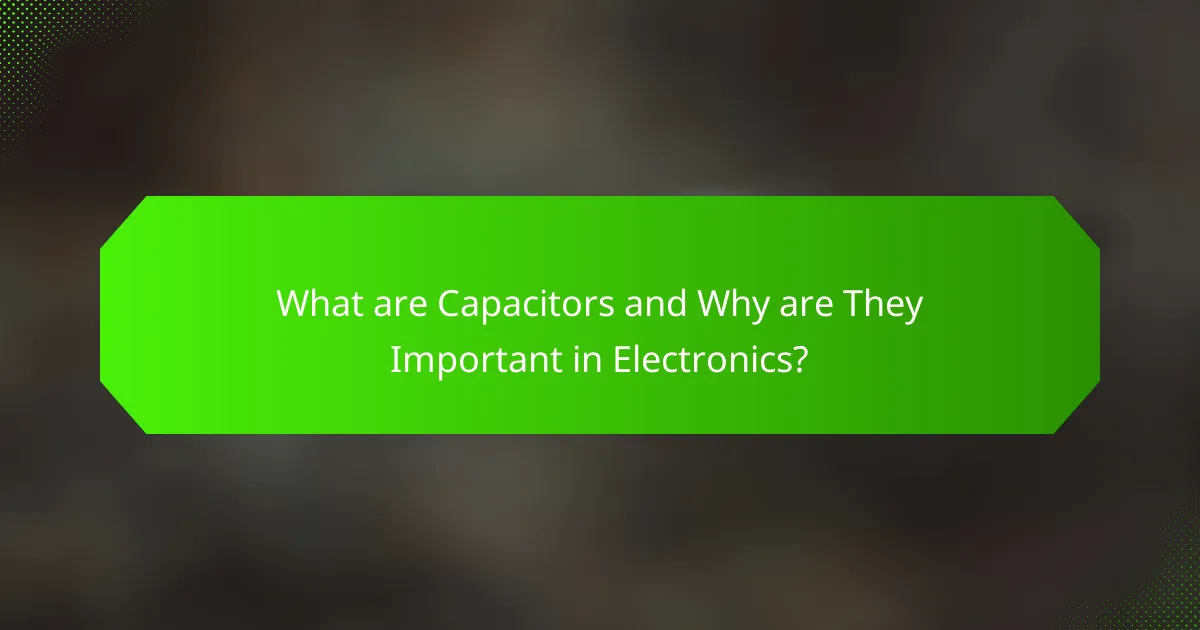Capacitors are passive electronic components that store and release electrical energy, consisting of two conductive plates separated by a dielectric material. This article provides a comprehensive overview of capacitors, detailing their various types, functions, and applications within electronic circuits. Key roles of capacitors include stabilizing voltage, filtering signals, and controlling timing intervals in oscillators. Their quick charge and discharge capabilities are essential for enhancing circuit performance and reliability, particularly in power supply circuits where they smooth voltage fluctuations. Understanding these aspects is crucial for anyone involved in electronics.

What are Capacitors and Why are They Important in Electronics?
Capacitors are passive electronic components that store and release electrical energy. They consist of two conductive plates separated by an insulating material known as a dielectric. Capacitors play a crucial role in electronic circuits by stabilizing voltage and power flow. They are used for filtering, timing, and energy storage applications. For instance, in power supply circuits, capacitors smooth out fluctuations in voltage. In timing applications, they help control the timing intervals in oscillators. Their ability to charge and discharge quickly makes them essential for various functions in electronics. Capacitors are vital for maintaining circuit performance and reliability.
How do Capacitors function in electronic circuits?
Capacitors store and release electrical energy in electronic circuits. They consist of two conductive plates separated by an insulating material called a dielectric. When voltage is applied, an electric field forms between the plates, causing charge to accumulate. The amount of stored charge depends on the capacitance value, which is measured in farads. Capacitors release energy when the circuit requires it, smoothing out voltage fluctuations. They also filter signals and store energy for quick discharge. These functions are crucial in power supply circuits and signal processing applications.
What are the basic principles behind capacitor operation?
Capacitors operate based on the principle of storing electrical energy in an electric field. When a voltage is applied across the terminals of a capacitor, an electric field develops between the conductive plates. This field allows the capacitor to store charge. The amount of charge stored is proportional to the voltage applied, described by the equation Q = CV, where Q is charge, C is capacitance, and V is voltage. Capacitors can release this stored energy when needed, providing power to circuits. This operation is fundamental in filtering, timing, and energy storage applications in electronic circuits.
How do capacitors store and release electrical energy?
Capacitors store electrical energy by accumulating charge on their plates. When a voltage is applied, electrons move to one plate, creating a negative charge. The opposite plate loses electrons, resulting in a positive charge. This separation of charges creates an electric field between the plates. The amount of energy stored is proportional to the capacitance and the square of the voltage, described by the formula E = 1/2 CV². Capacitors release energy when the circuit is closed, allowing the stored charge to flow. This discharge can power devices or smooth out voltage fluctuations in circuits.
What are the different types of capacitors?
There are several types of capacitors used in electronic circuits. The main types include ceramic capacitors, electrolytic capacitors, tantalum capacitors, film capacitors, and supercapacitors. Ceramic capacitors are commonly used for high-frequency applications. They exhibit low losses and are available in various capacitance values. Electrolytic capacitors are polarized and often used for power supply filtering. They have higher capacitance values but are limited to DC applications. Tantalum capacitors are also polarized and known for their stability and reliability. Film capacitors are non-polarized and suitable for applications requiring low leakage. Supercapacitors provide high capacitance and are used for energy storage solutions. These categories cover the primary types of capacitors found in electronic circuits.
What is the difference between ceramic, electrolytic, and film capacitors?
Ceramic, electrolytic, and film capacitors differ in construction, dielectric material, and applications. Ceramic capacitors use a ceramic dielectric, offering stability and low losses. They are commonly used in high-frequency applications. Electrolytic capacitors utilize an electrolyte as one electrode, providing high capacitance values in a compact size. They are often used in power supply circuits. Film capacitors consist of thin plastic film as the dielectric, known for their reliability and low distortion. They are ideal for audio applications. Each type has distinct properties that make them suitable for specific electronic functions.
How do supercapacitors differ from traditional capacitors?
Supercapacitors differ from traditional capacitors primarily in their energy storage capacity and charge/discharge rates. Supercapacitors can store significantly more energy than traditional capacitors due to their larger surface area and electrostatic charge storage mechanism. Traditional capacitors typically store energy through dielectric materials, limiting their energy density.
Supercapacitors can achieve energy densities of up to 10 Wh/kg, while traditional capacitors usually range from 0.1 to 0.5 Wh/kg. Additionally, supercapacitors can charge and discharge much faster than traditional capacitors, often within seconds. This rapid charge/discharge capability makes them suitable for applications requiring quick bursts of energy.
In contrast, traditional capacitors are often used for smoothing out voltage fluctuations in power supply circuits. Therefore, the fundamental differences lie in their design, energy storage mechanisms, and applications.
What are the key attributes of capacitors?
Capacitors store electrical energy in an electric field. Their key attributes include capacitance, voltage rating, equivalent series resistance (ESR), and leakage current. Capacitance is measured in farads and indicates the amount of charge a capacitor can store. The voltage rating specifies the maximum voltage a capacitor can withstand without failure. ESR represents the internal resistance that affects performance, especially in high-frequency applications. Leakage current is the small amount of current that flows through a capacitor when it is not in use. These attributes determine a capacitor’s suitability for various electronic applications.
What are the capacitance values and how are they measured?
Capacitance values represent the ability of a capacitor to store electrical charge. They are measured in farads (F), with common subunits including microfarads (µF) and picofarads (pF). Capacitance can be determined using a capacitance meter or multimeter set to the capacitance measurement mode. The capacitor is connected to the device, which applies a voltage and measures the resulting charge. The calculated ratio of charge to voltage gives the capacitance value. Standard capacitors often have marked capacitance values, which can be confirmed with measurement tools for accuracy.
How does voltage rating affect capacitor selection?
Voltage rating directly influences capacitor selection by determining the maximum voltage the capacitor can safely handle. Selecting a capacitor with an insufficient voltage rating can lead to failure, including breakdown or explosion. Capacitors are typically rated with a voltage that indicates their safe operating limit. For instance, a capacitor rated at 50V should not be used in a circuit where the voltage exceeds this limit. Exceeding the voltage rating can cause dielectric breakdown, leading to short circuits or damage to the circuit. Therefore, it is crucial to choose a capacitor with a voltage rating higher than the maximum voltage expected in the application. This practice ensures reliability and longevity of the capacitor in electronic circuits.
What applications utilize capacitors in electronic circuits?
Capacitors are utilized in various applications within electronic circuits. They are commonly used for energy storage, smoothing out voltage fluctuations in power supplies. In timing circuits, capacitors help control the timing intervals by charging and discharging at specific rates. Coupling and decoupling applications use capacitors to filter signals and stabilize voltage levels. Additionally, capacitors are essential in audio equipment for filtering and enhancing sound quality. In radio frequency circuits, they are used for tuning and frequency selection. Each application demonstrates the fundamental role capacitors play in enhancing circuit performance and reliability.
How are capacitors used in power supply circuits?
Capacitors are used in power supply circuits primarily for filtering and energy storage. In filtering applications, capacitors smooth out voltage fluctuations by absorbing excess voltage and releasing it when needed. This action stabilizes the output voltage and reduces ripple in the power supply.
In energy storage, capacitors provide a quick release of energy during peak demand. This helps maintain a steady voltage level. Capacitors also assist in decoupling, isolating different parts of a circuit to prevent interference.
The effectiveness of capacitors in these roles is supported by their ability to charge and discharge rapidly. This characteristic is crucial for maintaining performance in electronic devices.
What role do capacitors play in signal processing and filtering?
Capacitors play a crucial role in signal processing and filtering. They store and release electrical energy, which helps in managing voltage levels in circuits. In filtering applications, capacitors can block direct current (DC) while allowing alternating current (AC) to pass. This property is essential in creating high-pass and low-pass filters. High-pass filters use capacitors to eliminate low-frequency signals. Low-pass filters, conversely, utilize capacitors to suppress high-frequency signals. Additionally, capacitors can smooth out voltage fluctuations in power supplies, ensuring stable signal processing. Their ability to phase shift signals is also critical in various signal conditioning applications. These characteristics make capacitors indispensable in electronic circuits for effective signal management.
How do capacitors contribute to circuit stability and performance?
Capacitors contribute to circuit stability and performance by storing and releasing electrical energy. They smooth out voltage fluctuations in power supplies. This action helps maintain a steady voltage level, which is crucial for sensitive electronic components. Capacitors also filter out noise in signal processing applications. By doing so, they enhance the clarity and quality of the signals. Additionally, capacitors can provide reactive power, improving the overall efficiency of the circuit. Their ability to charge and discharge quickly makes them essential for timing applications. Studies have shown that circuits with properly sized capacitors exhibit better transient response and stability.
What is the impact of capacitors on frequency response in circuits?
Capacitors significantly impact frequency response in circuits. They store and release electrical energy, affecting how signals behave at different frequencies. At low frequencies, capacitors block DC signals and allow AC signals to pass. As frequency increases, capacitors provide lower impedance, allowing more current to flow. This behavior leads to phase shifts in the circuit. For instance, in RC circuits, capacitors cause a 90-degree phase shift at the cutoff frequency. This frequency response is crucial in filtering applications. Capacitors are used in high-pass and low-pass filters to control signal frequencies. Their value determines the cutoff frequency and the overall response of the circuit.
How do capacitors affect transient response in electronic devices?
Capacitors significantly influence transient response in electronic devices by storing and releasing electrical energy. They help smooth out voltage fluctuations during sudden changes in current, which is crucial for maintaining circuit stability. When a transient event occurs, such as a sudden load change, capacitors can quickly discharge or charge to counteract the impact. This action minimizes voltage spikes and dips, protecting sensitive components. Additionally, capacitors can filter high-frequency noise, enhancing overall performance. Their ability to respond rapidly to changes makes them essential in power supply circuits and signal processing applications.
What are common issues and troubleshooting tips for capacitors?
Common issues with capacitors include leakage, short circuits, and failure to charge or discharge properly. Leakage occurs when the dielectric material breaks down, allowing current to flow through the capacitor. Short circuits happen when internal connections fail, causing a direct path for current. Failure to charge or discharge can result from incorrect voltage ratings or aging components.
Troubleshooting tips involve checking for physical damage, measuring capacitance with a multimeter, and ensuring proper voltage levels are maintained. Visual inspection can reveal bulging or leaking capacitors. A multimeter can confirm if a capacitor is functioning within its rated capacitance. Maintaining voltage levels prevents premature failure.
How can you identify a faulty capacitor in a circuit?
To identify a faulty capacitor in a circuit, visually inspect it for bulging or leakage. A bulging capacitor indicates internal pressure buildup, which is a sign of failure. Leakage of electrolyte fluid also suggests that the capacitor is faulty. Additionally, use a multimeter to test the capacitor’s capacitance. A reading significantly lower than the rated value indicates a problem. Furthermore, check for continuity; a shorted capacitor will show continuity, confirming it is defective. Lastly, observe circuit performance; if the circuit is malfunctioning and the capacitor is suspected, it may need replacement.
What are best practices for capacitor replacement and maintenance?
The best practices for capacitor replacement and maintenance include ensuring proper identification of the capacitor type and specifications before replacement. Always discharge capacitors safely to prevent electrical shock. Use capacitors with the same voltage rating or higher to maintain circuit integrity. When replacing, solder connections should be secure and clean to ensure good electrical contact. Inspect surrounding components for damage or wear during maintenance. Regularly check for signs of leakage or bulging in capacitors, as these indicate failure. According to the Electronic Industries Alliance, maintaining capacitors can extend their lifespan and improve circuit performance.
Capacitors are passive electronic components essential for storing and releasing electrical energy in circuits. This article explores the various types of capacitors, including ceramic, electrolytic, and supercapacitors, along with their functions such as filtering, timing, and energy storage. It discusses the principles of capacitor operation, key attributes like capacitance and voltage rating, and their applications in power supply circuits and signal processing. Additionally, the article addresses common issues, troubleshooting tips, and best practices for capacitor maintenance and replacement, providing a comprehensive understanding of capacitors and their role in enhancing circuit performance and reliability.



